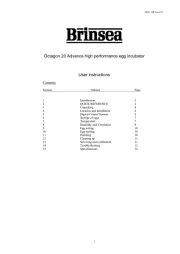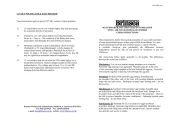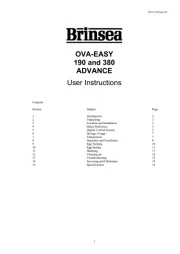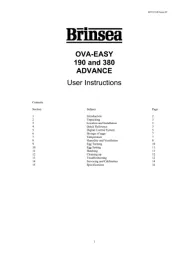
CP01GB Issue 6
12 VOLT POLYHATCH & HATCHMAKER
These instructions apply to special 12V.DC versions of these products.
32. 12 volt products are for low voltage supply only and must never
be connected directly to the mains.
33. Connect to a 12 volt vehicle battery observing the polarity,
brown to +, blue to -. The condition of the battery and room
temperature will determine the interval between charges.
34. Maximum continuous current consumption will be 4.0 Amp
(Polyhatch) or 2.5 Amp (Hatchmaker). A fully charged 40
Ampere/hour battery will operate a Polyhatch for at least 10
hours. (4 Amps x 10 hours = 40 Ampere/hour). Twice this life
may be expected in reasonable ambient temperatures.
35. 12 volt products may be run from the 230v mains supply via a
transformer/rectifier or a battery charger suitable for the current
indicated above. The voltage may be from 11 to 14 volts DC.
Some small temperature adjustment may be necessary when
changing between different supplies.
Brinsea Products Ltd, Station Road, Sandford, N. Somerset, BS25 5RA
Tel: 0845 226 0120 Fax: (01934) 820250
e-mail:
sales@brinsea.co.uk, website: www.Brinsea.co.uk
HATCHMAKER, POLYHATCH & HATCHMASTER
STILL AIR INCUBATORS & HATCHERS
USER INSTRUCTIONS
These instructions outline the essential procedure for successful incubation
of most domesticated species in this range of still air incubators. For more
detailed information and for less common species, a variety of books
is available. However, note particularly the differences between
temperatures quoted for still air and forced air incubators in any text
references.
The instructions below apply generally to all models. The differences
between the models are as follow:
Hatchmaker
: For use as a manual turning incubator or as a hatcher.
Automatic egg turning is not applicable. Humidity pans are in the form
of two concentric rings moulded in the base beneath the egg tray. Access by
removing the egg tray or pouring water through the egg tray.
Polyhatch
: Incubator with automatic egg turning. Humidity pans
are moulded into either side of the base with pouring channels accessible
under the tray end covers. Packaging includes spare turning arm – do not
throw away.
Hatchmaster A
: Incubator with automatic egg turning. Humidity pans
are in the base with filling slots outside the incubator front. Damper lever
to control fresh air inlet in the centre of the front of the incubator. Move to
the left to reduce humidity (increase ventilation). Packaging include spare
turning arm – do not throw away.
Hatchmaster H
: Intended for use as a hatcher for eggs incubated
in another machine. Automatic egg turning not applicable. Humidity pans
in the base with filling slots outside the incubator front. Lift-out window
provided for easy access to chicks.















